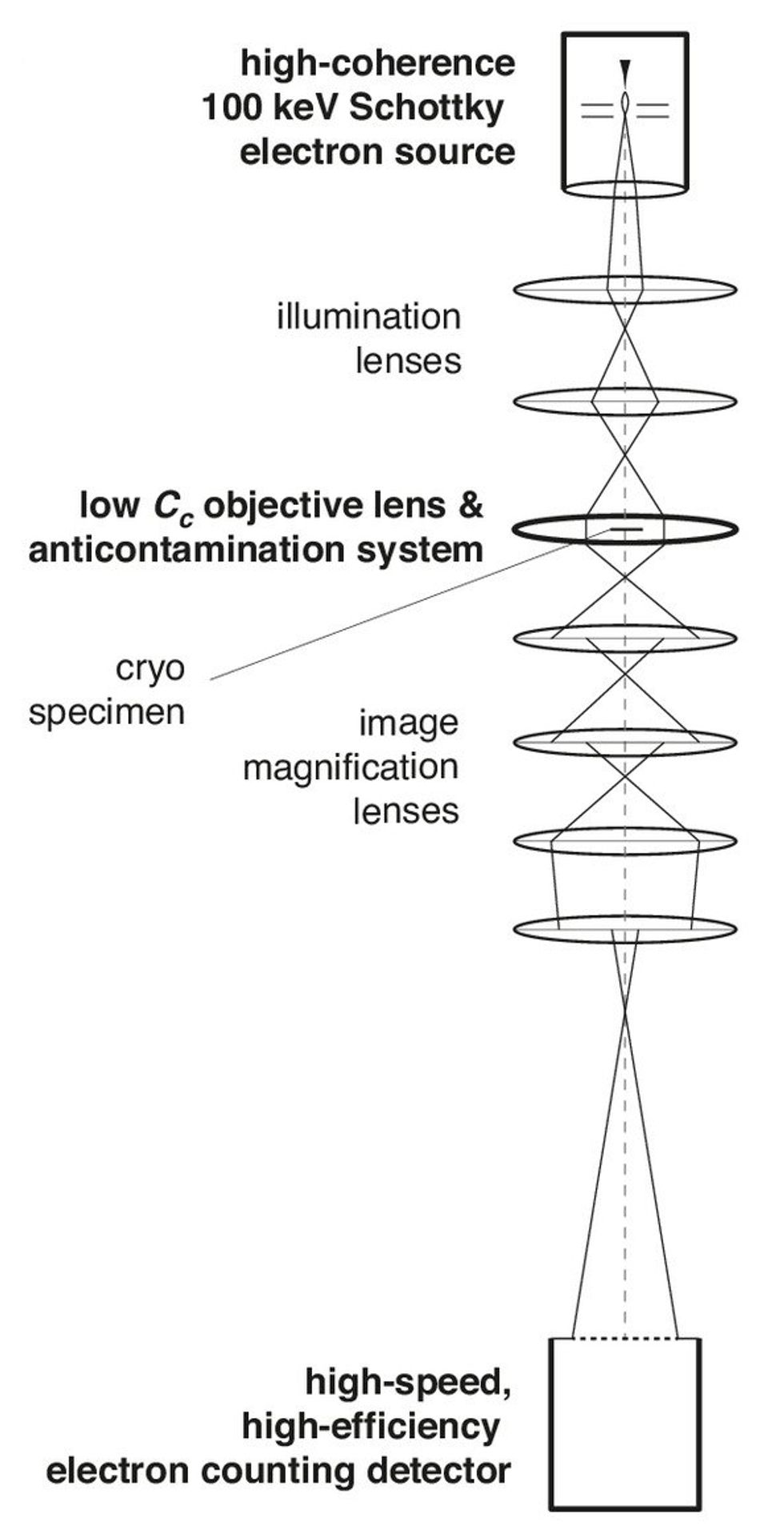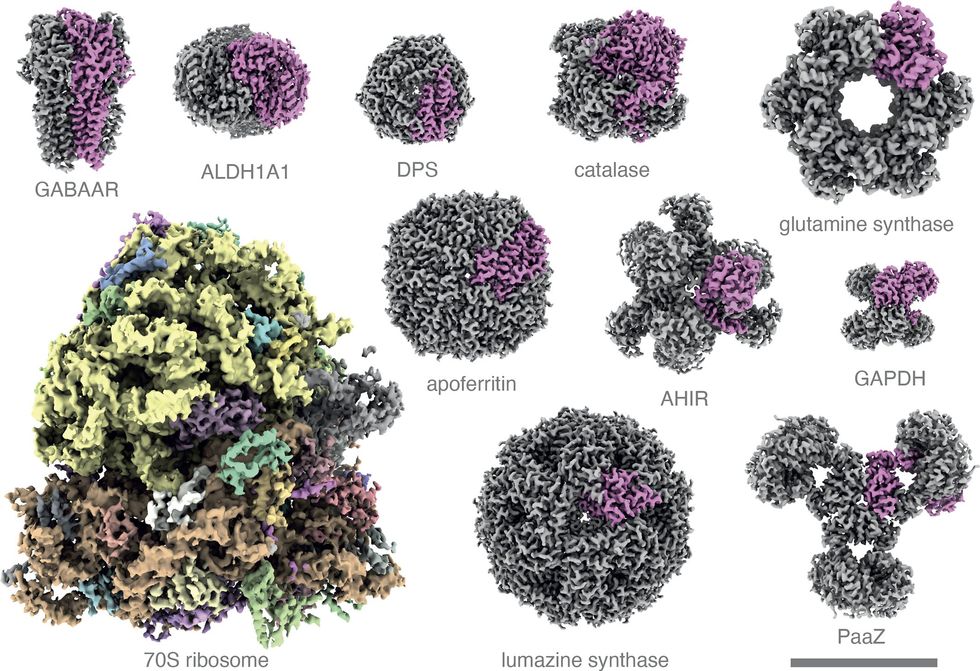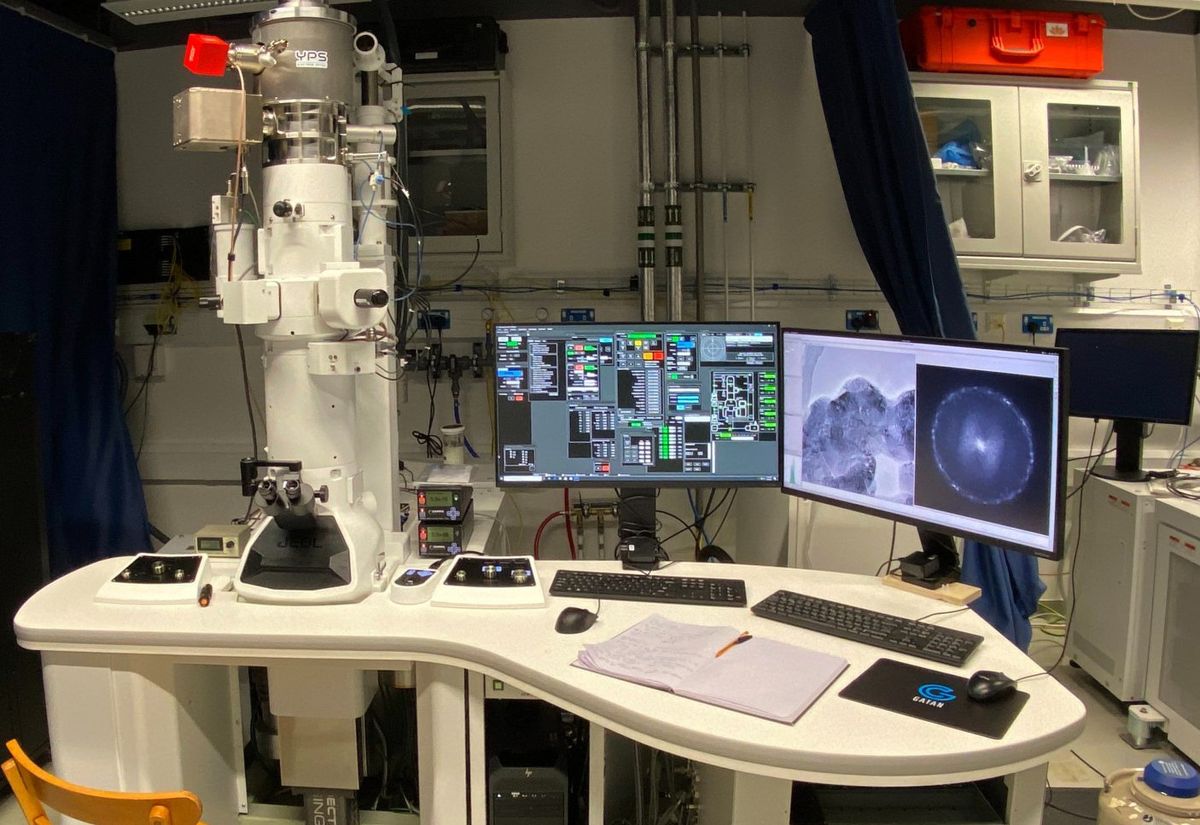Over the past decade, cryo-electron microscopy (cryoEM) has emerged as a powerful tool for determining the detailed structures of complex molecules. Now, a new design from researchers at the Medical Research Council’s Laboratory of Molecular Biology (MRC-LMB) in the United Kingdom and their collaborators could slash the cost of cryoEM by 90 percent. This could bring structural studies in biology and material science within reach of researchers who must currently send their samples out to regional centers or colleagues at wealthier organizations.

In cryoEM, an electron beam between 100 kiloelectron volts and 300 keV passes through the sample—a collection of single molecules (averaging 5 to 40 nanometers in diameter) isolated and immobilized in an ultra-thin layer of ice less than 60 nm thick. The beam can produce conventional transmission electron micrograph (TEM) images, but without additional steps for TEM’s staining or polymer fixation. And the extremely low temperatures of cryoEM reduce thermal motion in the sample and the stabilizing medium while reducing damage to the sample from the electron beam. The result: CryoEM can produce diffraction patterns that yield atom-by-atom structures of complex molecules, a resolution impossible at room temperature.
The researchers took hundreds of micrographs covering tens of thousands of individual molecules in different orientations. They combined the micrographs to build high-resolution (about 0.3 nm) 3D pictures.
Nature Methods named cryoEM its “2015 Method of the Year.’’ The 2017 Nobel Prize in Chemistry went to University of Lausanne’s Jacques Dubochet, Columbia University’s Joachim Frank, and MRC-LMB’s own Richard Henderson. CryoEM applications have exploded in the years since.
Conventional cryoEM is expensive, though. A top-end instrument throwing a 300 keV electron beam costs at least US $5 million to buy. Building the facility to support and house the machine can cost almost as much again. And operating it costs thousands of dollars a day.
By comparison, the MRC-LMB researchers built their new cryo-electron microscope for just $500,000, says Christopher Russo, a researcher at MRC-LMB and one of the authors of a paper detailing the work, published 27 November in the Proceedings of the National Academy of Sciences (PNAS). Total retail costs of a commercial 100 keV microscope might ultimately be a little higher.
“It could be that once the instrument is put together into a polished product with a service contract, it might be a bit more,” says Russo, “but hopefully well under $1 million, which puts it in the reach of individual groups and standard equipment grant calls…We are talking with all the microscope manufacturers to encourage them to take on commercializing a product following this prototype.”
In the meantime, says Russo, “People can build one up from the same combination of parts, or even upgrade older microscopes that are suitable. But we expect most people would prefer to be able to buy a new one all assembled and installed.”
Eleven Complex Biomolecules
Russo and colleagues used their microscope to produce 3D molecular structures for 11 complex biomolecules. The MRC-LMB system does not yet have quite the resolution of 300 keV systems; a top commercial machine yielded 10 to 25 percent better resolution than the 100 keV prototype, according to the PNAS paper, but Russo and his colleagues are optimistic that they can close the gap.

Even so, affordable 100 keV cryoEM offers several advantages of its own. The scans produce more useful structure information before damage from the electron beam makes the sample unusable. This means that investigators can run more scans on a sample to build up high-resolution images. Having cryoEM on-site eliminates delays from shipping samples, waiting for samples to be run, waiting to find out that a sample was unreadable, and waiting for results. This closes “the loop between specimen preparation, optimisation, and data collection to hours rather than days or weeks,” the researchers wrote in their paper. With automated sample handling and larger detectors, they say, collecting data for determining atomic structures could ultimately take only a few minutes.
Some researchers outside of the project like low-cost cryoEM’s chances. Ed Eng manages the National Center for CryoEM Access and Training at the New York Structural Biology Center, one of the three U.S. national cryoEM center, and Jason de la Cruz manages the CryoEM Facility at the Sloan Kettering Institute in New York City. They agree that the MRC-LMB’s goal of reducing cryoEM costs by an order of magnitude is credible, and they welcome the effort.
“If the use of 100 keV electrons for single-particle analysis (SPA) proves to be superior to SPA data collection on high-end machines,” Eng and de la Cruz wrote in an email, “then SPA may move to 100 kV [microscopes] in the future, leaving the high-kV ‘scopes dedicated for thick samples, cryo-electron tomography, and [microcrystal electron diffraction].”
De la Cruz notes that, “This innovation also opens up the possibility of much-needed competition in cryoEM microscope and detector manufacturers. Thermo Fisher Scientific has dominated the cryoEM space in the past decade with its instruments; however, this development may spur traditional EM manufacturers, such as JEOL Ltd. and Hitachi High-Tech Corporation, to develop their own low-keV cryoEM TEMS.”
Eng adds, “For structural studies, a 100 keV instrument will make a broad impact on low resource institutions and provide a viable pathway for those scientists to be able to use cryoEM sustainably in their research programs.”
- Artificial Antibodies Bolster Hope for Inhaled Coronavirus Treatment ... ›
- A (Very) Close Look at Carbon Capture and Storage - IEEE Spectrum ›
Douglas McCormick is a freelance science writer and recovering entrepreneur. He has been chief editor of Nature Biotechnology, Pharmaceutical Technology, and Biotechniques.



